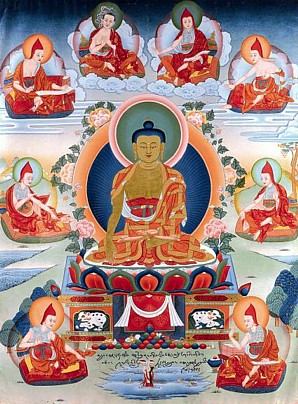Shastra

Shastra (Skt. śāstra; Tib. བསྟན་བཅོས་, tenchö, Wyl. bstan bcos) — a treatise or commentary upon the words of the Buddha (Tib. བཀའ་, ka, Wyl. bka’). In Tibet, many of the most important shastras composed by the great Indian masters of the past were compiled into a collection known as the Tengyur, or translated treatises, comprising around 228 volumes (depending on the edition).
Commentary
The Sutra Requested by Devaputra says:
ལེགས་པར་གསུངས་དང་དེའི་དགོངས་འགྲེལ་བ། །
དེའི་དབང་གིས་ཤཱཀྱའི་བསྟན་པ་ནི། །
All Dharma teachings are included in the Buddha’s word and the treatises,
The excellent speech and the commentaries on its intended meaning,
By means of these, the teaching of the Śakya
Will remain for long within this world.
- Buddha Shakyamuni, Sutra Requested by Devaputra
As this says, all the excellent teachings of the Dharma can be included within two categories: the speech of the victorious Buddha and the treatises which provide commentaries on its intended meaning.
Vasubandhu said:
- That which subdues all the enemies, one’s own afflictions,
- And guards against future existence in the lower realms,
- Is called a ‘treatise’, because it subdues and protects,
- These two features are not found in other traditions.
- --Well Explained Reasoning
Patrul Rinpoche says:
- There are four obstacles which can prevent those with understanding from taking interest in a particular treatise. They are:
- thinking that it is devoid of any purpose,
- thinking that it has a purpose but that one would never be able to accomplish it,
- thinking that although possible it is not something an honourable person would wish to pursue, or
- thinking that even though it is honourable, there are other easier methods or that there is a lack of connection (between the methods and the goal).
- In the present case, if we take each of these in turn, then:
- unlike a treatise on dentistry for crows, for example, generally there is some purpose to it.
- Furthermore that purpose is achievable, so it is not like a treatise on stealing the crown jewel from the naga king.
- Not only that, but the aim, which is achievable, is also a sublime aim for individuals to pursue, so it is not like a treatise on how to marry your mother.
- Then, it is not that the methods for accomplishing this supreme objective bear no relation to what is in the treatise, as in the case of [a text about] sacrificing animals in order to gain rebirth in the higher realms.
- --From An Overview of The Ornament of Clear Realization, the Treatise of Essential Instructions on Transcendental Wisdom
Nine Kinds of Shastra
Of the nine kinds of shastra (Tib. བསྟན་བཅོས་དགུ་, tenchö gu, Wyl. bstan bcos dgu) listed below, only the first, sixth, and ninth are valid and authentic, that is, they are the three kinds of true shastras (Tib. བསྟན་བཅོས་ཡང་དག་གསུམ་, tenchö yangdak sum, Wyl. bstan bcos yang dag gsum); the other six are to be discarded.
- Shastras on appropriate subjects (Tib. དོན་དང་ལྡན་པའི་བསྟན་བཅོས་, dön dang denpé tenchö, Wyl. don dang ldan pa'i bstan bcos)
- Shastras on inappropriate subjects (Tib. དོན་ལོག་པའི་བསྟན་བཅོས, dön lokpé tenchö, Wyl. don log pa'i bstan bcos)
- Shastras on meaningless subjects (Tib. དོན་མེད་པའི་བསྟན་བཅོས་, dön mepé tenchö, Wyl. don med pa'i bstan bcos)
- Shastras written to gain fame for the author (Tib. ཐོས་པ་ལྷུར་ལེན་པའི་བསྟན་བཅོ་, töpa lhurlenpé tenchö, Wyl. thos pa lhur len pa'i bstan bcos)
- Shastras written to incite controversy (Tib. རྩོད་པ་ལྷུར་ལེན་པའི་བསྟན་བཅོས་, tsöpa lhurlenpé tenchö, Wyl. rtsod pa lhur lenpa'i bstan bcos)
- Shastras written to inspire spiritual practice (Tib. སྒྲུབ་པ་ལྷུར་ལེན་པའི་བསྟན་བཅོས་, drubpa lhurlenpé tenchö, Wyl. sgrub pa lhur len pa'i bstan bcos)
- Deceitful shastras (Tib. ངན་གྱོའི་བསྟན་བཅོས་, ngen gyö tenchö, Wyl. ngan gyo'i bstan bcos)
- Shastras not inspired by loving kindness (Tib. བརྩེ་བ་དང་བྲལ་བའི་བསྟན་བཅོས་, tsewa dang dralwé tenchö , Wyl. brtse ba dang bral ba'i bstan bcos)
- Shastras that free one from the sufferings of the lower realms of samsara (Tib. ངན་སོང་དང་ངན་གྲོའི་སྡུག་བསྔལ་འབྱིང་པར་བྱེད་པའི་བསྟན་བཅོས་, ngensong dang ngen drö dukngal jingpar jepé tenchö, Wyl. ngan song dang ngan gro'i sdug bsngal 'bying par byed pa'i bstan bcos)[1]
References
- ↑ Dilgo Khyentse Rinpoche, The Heart Treasure of the Enlightened Ones, Note 10, page 215. Also see The Heart of Compassion, page 197.